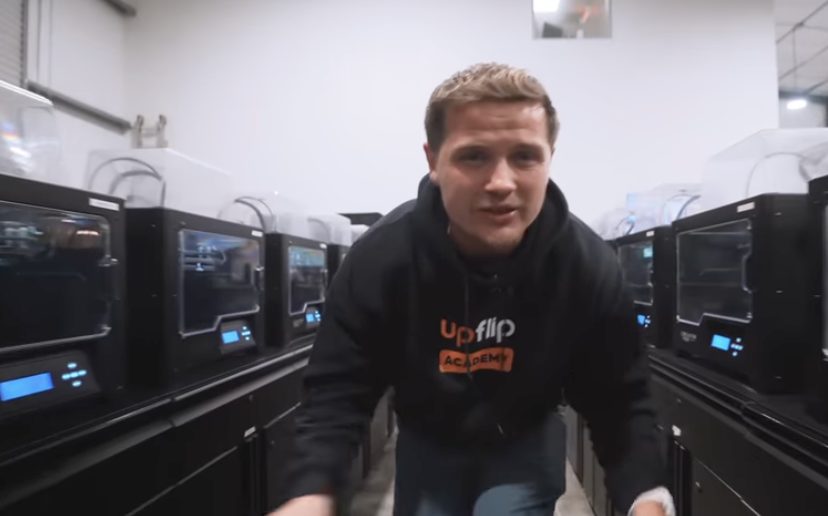Travis never expected a 3D printer tucked away in his closet would become the foundation of a multi-million dollar business. Yet that’s exactly what happened when he discovered the untapped potential of 3D printing technology.
What began as a self-funding hobby generating $10-15,000 in its first year has transformed into a manufacturing powerhouse producing 2,000-3,000 parts daily and projecting $7-8 million in revenue for 2025. The journey wasn’t always smooth, but it taught him valuable lessons about entrepreneurship, scaling a business, and finding opportunity in unexpected places.
Starting Small: The Humble Beginnings
Travis’s introduction to 3D printing came during college when he was exposed to a rapid prototyping machine. Years later, when consumer-grade machines became affordable, he purchased his first 3D printer for around $1,200—a far cry from the quarter-million dollar industrial machines of the past.
With nowhere else to put it, he set up shop in his office closet. His goal was modest: have a self-funding hobby where the printer could pay for itself and cover material costs for his personal projects. To his surprise, that first machine paid for itself within a month.
The math was simple and compelling. If one machine could generate $25-50 daily, two machines could double that. This linear scalability made forecasting straightforward:
-
Year 1 (part-time): $10,000-$15,000
-
Year 2 (part-time): $30,000-$40,000
-
Year 3 (part-time): $70,000-$80,000
By year three, Travis had expanded from the closet to his children’s playroom, running about ten machines. They were literally flipping circuit breakers trying to keep everything running. It was time for a decision: stagnate, scale back, or go big.
The Turning Point: From Hobby to Full-Time Business
While Travis had the vision to pursue 3D printing full-time, he lacked the courage to leave his safety net. He took preliminary steps—securing a lease on a facility and exploring hiring options—but couldn’t make the final leap.
Then fate intervened. About a month after signing the lease, Travis was laid off from his job. Rather than panic, he felt relief. This was the push he needed. He went home, told his wife, and two hours later, he was working on his business.
Travis had three years’ worth of data and a big vision he wanted to pursue, but he just didn’t have the guts to do it at the time… When he got laid off, he honestly just thought, “Well, this is really what I wanted.”
Going full-time accelerated growth dramatically:
-
Year 4 (first full-time year): $180,000
-
Year 5: $380,000
-
2024: Just under $5 million
Breaking Common Misconceptions
One of the biggest myths about starting a 3D printing business is that you need to be an engineer. While technical knowledge helps, today’s printers are remarkably user-friendly. About half of my employees have engineering backgrounds, but some of our best team members have zero technical experience.
Another misconception is that 3D printed parts are weak or fragile. Modern materials and technologies have evolved dramatically. The parts we produce can withstand extreme environments, with materials like PEEK that can handle almost anything thrown at them.
The real question isn’t whether you can 3D print something – 80% of the time, you can. The question is whether you should. The answer depends on factors like how quickly you need to iterate designs and whether traditional manufacturing methods are feasible for your specific needs.
Finding Your Niche
If Travis could go back and give himself advice, he’d focus on specialization rather than trying to be everything to everyone. For too long, his team attempted to serve any industry and every customer, which led to some good opportunities but wasn’t sustainable long-term.
Each industry has its own language and requirements. When you don’t speak that language, clients immediately recognize you as an outsider. By focusing on specific industries and truly understanding their problems, Travis positioned himself as a valuable partner rather than just a service provider.
Marketing is another area Travis would have prioritized earlier. While they were fortunate to build a client base through relationships, the market is now far more aware of 3D printing capabilities than when they started. Today, differentiation is essential in an increasingly competitive landscape.
Scaling Challenges and Opportunities
As we’ve grown, certain aspects of the business have become easier while others have grown more complex. At our current scale, automation provides a much greater return on investment than was possible when we were smaller. What might have been manageable manually at 300-400 parts per day becomes impossible at 3,000-4,000 parts without automated systems.
Maintenance is a constant challenge – something breaks every single day. The question isn’t if but when and how badly. We stock hundreds of spare parts, anticipating failures before they happen. This proactive approach helps us maintain nearly 100% utilization, with 95-98% of our machines generating revenue on any given day.
Fear has been a recurring obstacle throughout our journey. Two major points required overcoming significant fear: going full-time and transitioning from consumer-grade to industrial-grade machines. In both cases, running the numbers and having confidence in the business potential helped me push through the uncertainty.
The entrepreneurial path isn’t easy, but the freedom to define your own schedule and build something meaningful makes the long hours worthwhile. For anyone considering starting their own 3D printing business, my advice is simple: start small, focus on providing value, and don’t be afraid to step outside your comfort zone.
Frequently Asked Questions
Q: Do I need technical expertise to start a 3D printing business?
No, you don’t need to be an engineer to succeed in 3D printing. While some technical background helps, modern printers are user-friendly enough that people from various backgrounds can operate them effectively. Many successful 3D printing entrepreneurs come from art, marketing, or finance backgrounds rather than engineering.
Q: How much does it cost to get started with 3D printing?
You can start with as little as $300-400 for a consumer-grade 3D printer. Materials cost around $13-15 per spool at retail prices (less with wholesale rates). As you grow, you can reinvest profits into additional machines or upgrade to more advanced equipment, but the initial investment is quite accessible for most people.
Q: What are the profit margins like in 3D printing?
Profit margins can be substantial in 3D printing. For example, a simple electrical connector might cost 40-50 cents to produce but sell for $150. A larger industrial part might cost $20 to produce but generate $75 in revenue. These margins allow for reinvestment in the business and sustainable growth over time.
Q: What types of products are best suited for 3D printing?
The best products for 3D printing are those that require customization, have complex geometries that would be difficult to produce with traditional methods, or need small production runs where tooling costs for injection molding would be prohibitive. Industries like medical (prosthetics/orthotics), aerospace, automotive, and custom consumer products are particularly well-suited.
Q: How do you find customers for a 3D printing business?
While paid advertising can help maintain visibility, most successful 3D printing businesses grow through relationships – including relationships with competitors. The industry is growing rapidly enough that collaboration often benefits everyone. Social platforms like LinkedIn, YouTube, and Instagram have proven effective for showcasing capabilities and connecting with potential clients.







